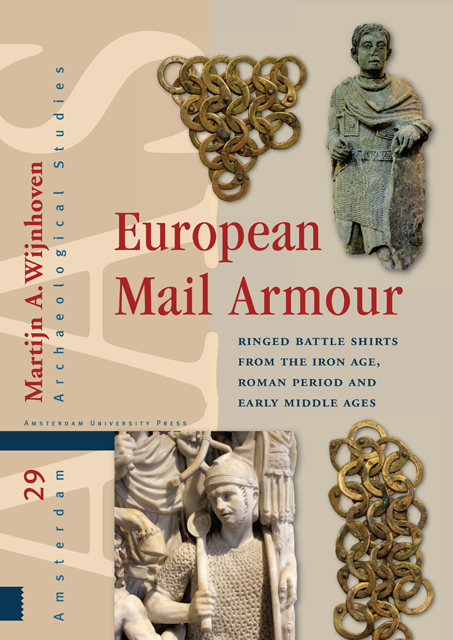Book contents
- Frontmatter
- Contents
- Acknowledgements
- Dedication
- 1 Introduction
- 2 The origins of mail armour
- 3 Distribution and archaeological context
- 4 The iconography of early mail armour
- 5 The naming of mail armour
- 6 Decoration in mail garments
- 7 Padded garments
- 8 The craft of making mail rings
- 9 Weaving patterns
- 10 The construction of mail garments
- 11 Ring characteristics
- 12 Final considerations
- Bibliography
- Database
- Appendix 1 Catalogue of mail armour
- Appendix 2 Catalogue of hybrid armour
- Appendix 3 Catalogue of isolated finds of fasteners and fixtures
- Appendix 4 Finds excluded from the database
9 - Weaving patterns
Published online by Cambridge University Press: 24 November 2022
- Frontmatter
- Contents
- Acknowledgements
- Dedication
- 1 Introduction
- 2 The origins of mail armour
- 3 Distribution and archaeological context
- 4 The iconography of early mail armour
- 5 The naming of mail armour
- 6 Decoration in mail garments
- 7 Padded garments
- 8 The craft of making mail rings
- 9 Weaving patterns
- 10 The construction of mail garments
- 11 Ring characteristics
- 12 Final considerations
- Bibliography
- Database
- Appendix 1 Catalogue of mail armour
- Appendix 2 Catalogue of hybrid armour
- Appendix 3 Catalogue of isolated finds of fasteners and fixtures
- Appendix 4 Finds excluded from the database
Summary
Understanding how a garment is made, and from what type of material, is key to understanding the manner in which it might be worn and how it was experienced on the body. The properties of any given textile will influence what can be made of it, and how it might be made.’
Mary Harlow & Marie-Louise Nosch
Weaving pattern refers to the repetitive manner in which the rings are placed and connected to form an integral structure that makes up the mail weave. Metal rings can be woven together in many different ways, each variant with its own unique qualities, and the options seem almost limitless. By the first millennium BC, various weave patterns to form a ringed mesh had been developed even before mail armour was invented (chapter 2.1). The great variety of weaving patterns can especially be observed in Japanese mail armour (kusari), which employs a wide array of ring configurations (fig. 9.1). This chapter will take a closer look at the patterns that prevailed in antiquity.
There are more than 600 entries of mail finds in the database that date from before the 5th century AD. The weaving pattern was determined through personal examination, whenever possible, supplemented by descriptions and photographs in literature. Often, the pattern could not be determined due to either poor preservation, or lack of a published detailed description. Nonetheless, the pattern was discernible in over 50% of the mail finds.
FOUR-IN-ONE PATTERN
Despite the numerous different manners in which rings may be linked together to form a mesh, all mail from antiquity is woven using the 4-in-1 pattern. In fact, this weaving pattern was prevalent in Europe since the invention of mail until its demise. It is also the only pattern observed among the medieval mail finds included in the database of this study, and it is the standard for all historical mail in Europe, from the Late Middle Ages to the Early Modern period. The exploration of other weaving patterns is seen only outside of Europe, and mainly in Japan.
- Type
- Chapter
- Information
- European Mail ArmourRinged Battle Shirts from the Iron Age, Roman Period and Early Middle Ages, pp. 211 - 222Publisher: Amsterdam University PressPrint publication year: 2021

